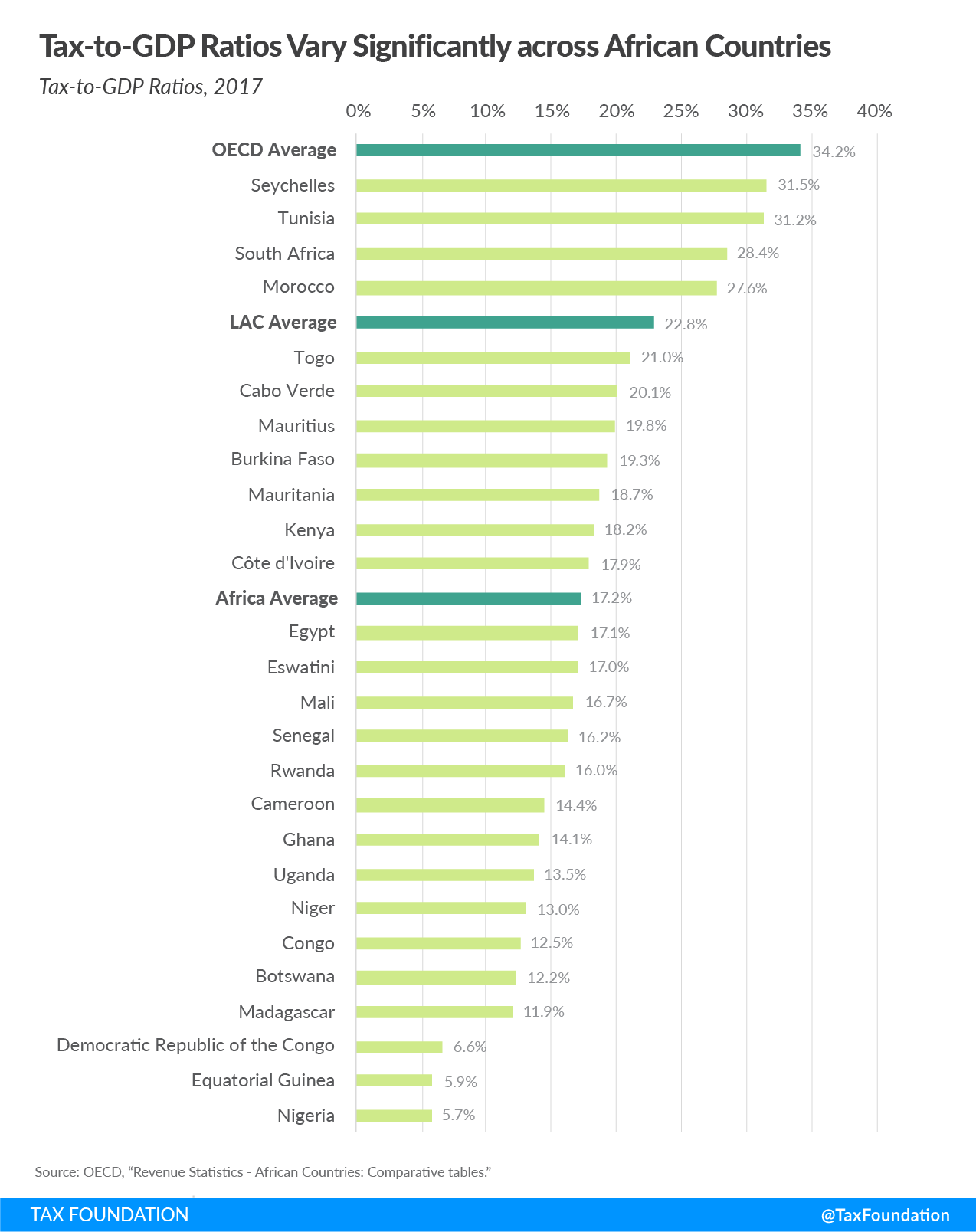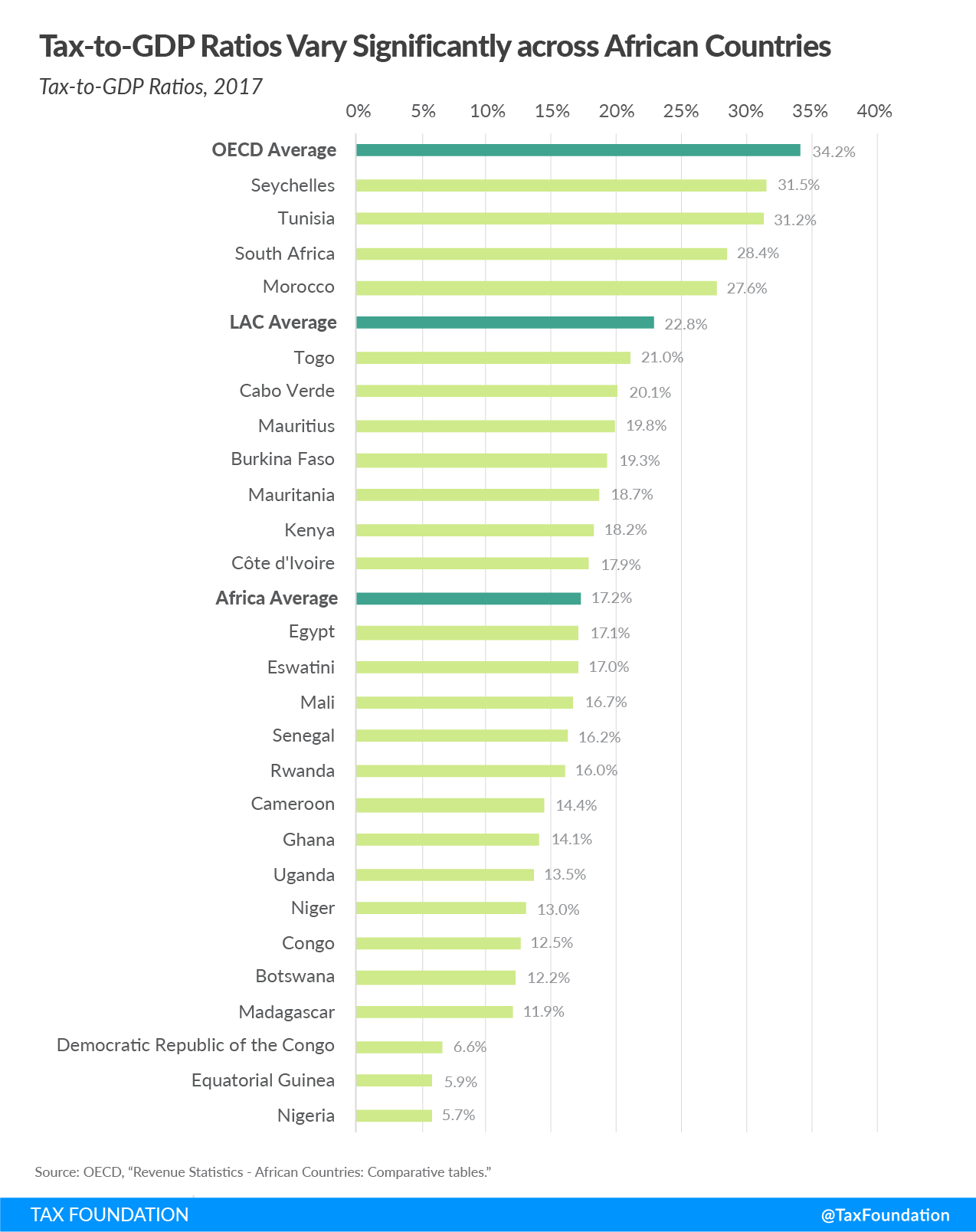Tax Policy – OECD Report: Tax Revenue in African Countries
The Organisation for Co-operation and Economic Development (OECD) has compiled tax revenue data for countries around the world—including 26 African countries, where tax revenue as a percent of GDP is on average lower than in other regions.
On average, this tax-to-GDP ratio for those 26 countries was 17.2 percent, compared to the OECD average of 34.2 and the Latin American and Caribbean (LAC) average of 22.8 percent.
The regional OECD report on tax revenue statistics in Africa covers the years 1997 to 2017, breaking down current tax structures in the region and how they have evolved over time.
Tax-to-GDP Ratios
Between 2008 and 2017, the average African tax-to-GDP ratio increased by 1.5 percentage points, from 15.7 percent to 17.2 percent, mainly due to revenue increases from value-added taxes (VAT, 0.7 percentage points) and individual income taxes (0.7 percentage points). The average ratio has plateaued at 17.2 percent since 2015, as increases in some countries offset decreases in others.
Tax-to-GDP ratios vary significantly across African countries, however. In 2017, Seychelles (31.5 percent), Tunisia (31.2 percent), and South Africa (28.4 percent) had the highest tax-to-GDP ratios of the 26 countries covered. Nigeria (5.7 percent), Equatorial Guinea (5.9 percent), and the Democratic Republic of the Congo (6.6 percent) had the lowest.
Sources of Tax Revenue
Taxes on goods and services were on average the greatest source of tax revenue for African countries, at 53.7 percent of total tax revenues in 2017. VAT contributed on average 29.4 percent, making it the most important tax on goods and services. Corporate taxes accounted on average for 18.6 percent of all tax revenues, and individual taxes accounted for 15.4 percent. Social insurance taxes and property taxes played less significant roles, at 8.1 percent and 1.6 percent, respectively.
On average, African countries’ tax structure is relatively similar to that of LAC countries. Notable differences are Africa’s relatively higher reliance on individual taxes and lower reliance on social insurance taxes. The average OECD tax structure differs quite substantially from that of the African average, as African countries tend to rely less on individual taxes, social insurance taxes, and property taxes, and more on corporate taxes and consumption taxes.
Between 2008 and 2017, revenue sources have shifted to VAT (increase of 1.7 percentage points of total taxes) and individual taxes (increase of 2.6 percentage points of total taxes). While the share of individual taxes is still lower than the share of corporate taxes, corporate tax revenue has declined by 1.2 percentage points of total tax revenue during the same time frame. Consumption taxes other than VAT have declined by 3.4 percentage points of total revenues.
The decline in consumption taxes other than VAT in many African countries is partly due to lower trade tax revenues. Trade liberalization across the region has led to reduced import tariffs, a narrower base of goods and services subject to excise taxes, and the elimination of taxes on exports, lowering overall trade tax revenues. The 2019 launch of the African Continental Free Trade Area (AfCFTA) will further reduce tariffs and thus decrease trade tax revenues in the short term. In the longer run, however, this decrease is expected to be offset by additional tax revenues resulting from economic growth generated by closer integration.
While not a focus of this blog post, the OECD publication also includes data on non-tax revenue, such as grants, property income, sales of goods and services, and other revenues. On average, non-tax revenues accounted for 43 percent of the amount of collected tax revenues in 2017. Non-tax revenue varied substantially among the countries covered, ranging from 18.7 percent of GDP in Botswana to 0.5 percent of GDP in South Africa. In almost all countries, non-tax revenues were lower than tax revenues.
VAT Revenue Ratios
The OECD report also includes VAT revenue ratios for the 26 African countries covered. This ratio looks at the difference between the VAT revenue actually collected and collectable VAT revenue under a theoretical VAT applied at the standard rate on all final consumption. The difference in actual and potential VAT revenues is due to 1) policy choices to exempt certain goods and services from VAT or tax them at a reduced rate, and 2) lacking VAT compliance. Higher VAT revenue ratios indicate a broader tax base, implying a more efficient VAT structure.
In 2016, the average African VAT revenue ratio stood at 0.37, lower than the LAC average (0.59) and OECD average (0.56). South Africa (0.66) and Togo (0.65) had the highest VAT revenue ratio, while Equatorial Guinea (0.07) and the Democratic Republic of the Congo (0.17) had the lowest ratios.
| Country | Individual Taxes | Corporate Taxes | Social Insurance Taxes | Property Taxes | Value-Added Taxes (VAT) | Consumption Taxes Other than VAT | Other |
|---|---|---|---|---|---|---|---|
| Botswana | 0.0% | 0.0% | 0.0% | 0.3% | 34.0% | 4.4% | 61.3% |
| Burkina Faso | 7.4% | 15.7% | 9.9% | 0.7% | 36.9% | 27.6% | 1.9% |
| Cabo Verde | 20.2% | 12.1% | 0.2% | 1.5% | 36.3% | 29.7% | 0.0% |
| Cameroon | 6.8% | 13.2% | 7.3% | 1.1% | 36.3% | 26.5% | 8.7% |
| Congo | 23.4% | 18.5% | 0.0% | 0.8% | 29.3% | 24.5% | 3.4% |
| Côte d’Ivoire | 0.3% | 11.2% | 11.5% | 2.6% | 20.0% | 41.9% | 12.6% |
| Democratic Republic of the Congo | 17.2% | 19.6% | 7.5% | 0.2% | 29.5% | 22.4% | 3.5% |
| Egypt | 9.6% | 27.7% | 15.0% | 0.6% | 21.1% | 22.9% | 3.0% |
| Equatorial Guinea | 11.6% | 66.2% | 0.0% | 0.0% | 12.4% | 8.6% | 1.1% |
| Eswatini | 30.9% | 17.9% | 13.3% | 2.3% | 24.8% | 10.7% | 0.0% |
| Ghana | 14.3% | 17.2% | 9.0% | 0.0% | 28.6% | 30.1% | 0.8% |
| Kenya | 24.9% | 12.9% | 2.5% | 0.7% | 24.0% | 27.9% | 7.1% |
| Madagascar | 11.1% | 12.4% | 3.5% | 0.6% | 48.1% | 24.0% | 0.4% |
| Mali | 7.7% | 16.5% | 10.5% | 2.2% | 29.4% | 29.3% | 4.5% |
| Mauritania | 12.5% | 20.9% | 2.0% | 0.2% | 31.8% | 32.5% | 0.1% |
| Mauritius | 9.8% | 14.7% | 4.1% | 5.5% | 34.1% | 29.5% | 2.2% |
| Morocco | 13.9% | 17.6% | 19.3% | 5.7% | 27.8% | 14.6% | 1.2% |
| Niger | 8.9% | 18.1% | 6.1% | 0.4% | 30.9% | 29.3% | 6.3% |
| Nigeria | 15.9% | 44.9% | 10.9% | 0.0% | 14.9% | 12.6% | 0.8% |
| Rwanda | 22.9% | 17.3% | 6.2% | 0.1% | 28.9% | 24.5% | 0.0% |
| Senegal | 15.5% | 9.6% | 7.2% | 2.5% | 34.8% | 26.5% | 3.9% |
| Seychelles | 14.0% | 21.2% | 0.0% | 1.4% | 33.1% | 30.4% | 0.0% |
| South Africa | 34.4% | 16.2% | 1.4% | 5.6% | 22.2% | 16.5% | 3.7% |
| Togo | 7.0% | 10.1% | 0.0% | 0.7% | 43.3% | 35.2% | 3.7% |
| Tunisia | 20.5% | 7.7% | 30.7% | 1.0% | 20.2% | 16.4% | 3.6% |
| Uganda | 24.7% | 6.1% | 0.0% | 0.0% | 31.6% | 33.2% | 4.3% |
| Africa Average | 15.4% | 18.6% | 8.1% | 1.6% | 29.4% | 24.3% | 2.6% |
| LAC Average | 9.5% | 15.5% | 16.9% | 3.4% | 27.9% | 21.8% | 4.9% |
| OECD Average | 23.9% | 9.2% | 26.2% | 5.7% | 20.2% | 12.2% | 2.7% |
|
Notes: The Latin American and Caribbean (LAC) average includes 25 countries, namely Argentina, the Bahamas, Barbados, Belize, Bolivia, Brazil, Chile, Colombia, Costa Rica, Cuba, the Dominican Republic, Ecuador, El Salvador, Guatemala, Guyana, Honduras, Jamaica, Mexico, Nicaragua, Panama, Paraguay, Peru, Uruguay, Trinidad and Tobago, and Venezuela. The OECD average includes the 36 OECD countries. Individual Taxes covers the OECD category 1100 Taxes on income, profits, and capital gains of individuals. Corporate Taxes covers the OECD category 1200 Taxes on income, profits, and capital gains of corporates. Social Insurance Taxes covers the OECD category 2000 Social security contributions (SSC). Property Taxes covers the OECD category 4000 Taxes on property. Value-Added Taxes (VAT) covers the OECD category 5111 Value-added taxes. Consumption Taxes Other than VAT covers the OECD category 5000 Taxes on goods and services minus the category 5111 Value-added taxes. Other covers the OECD categories 1300 Unallocable between 1100 and 1200; 3000 Taxes on payroll and workforce; 6000 Taxes other than 1000, 2000, 3000, 4000, and 5000; and Custom duties collected for the EU. Source: OECD, “Global Revenue Statistics Database,” https://stats.oecd.org/Index.aspx?DataSetCode=RS_GBL. |
|||||||
Source: Tax Policy – OECD Report: Tax Revenue in African Countries



